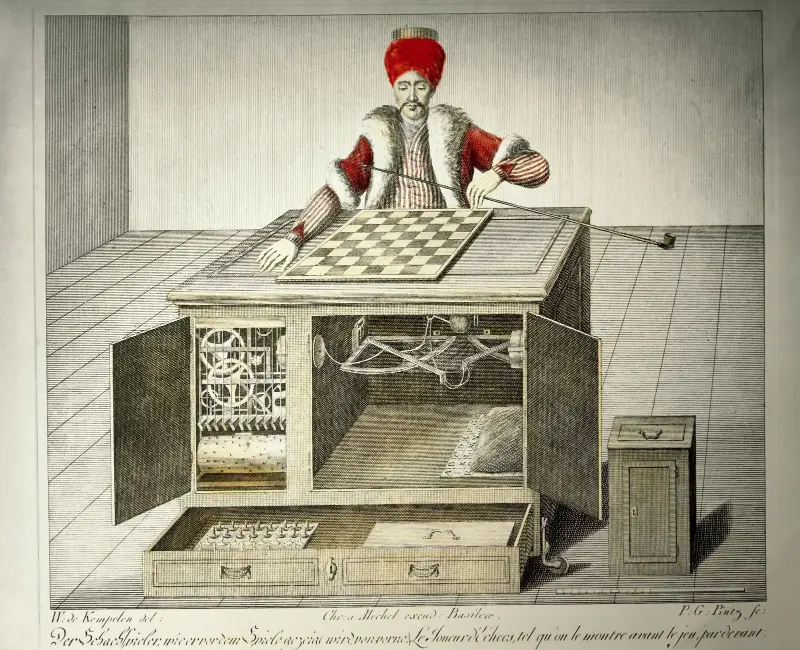Secrets of the Automaton
July 2024 - Solved 269🧩 Times
In this month’s historical puzzle we journey to Vienna, 1769. Empress Maria Theresa of Austria was hosting a glamorous event at the famed Schönbrunn Palace. French illusionist Francois Pelletier was entrancing the upper echelons of society with a unique act using magnets. Being of curious complexion, Maria had invited an eccentric member of her court, Hungarian inventor Wolfgang von Kempelen, to attend the performance in the hope he could unravel the tricks behind this fantastical act.
As the performance finished and the crowd applauded, blown away by the impossible absurdities they had witnessed, Kempelen was less than impressed. He vowed to the empress that he would construct a machine far more surprising and deceiving than Pelletier’s act. Intrigued, the empress excused him from his duties for six months so he could deliver on the promise.
Welcome to Secrets of the Automaton

An artist's impression of The Turk.
As vowed, six months later in 1770, Kempelen returned. With a grand swoop, he pulled back the covers and unveiled his masterful creation to the court. A motionless figure sat behind a chess table, wrapped in robes, wearing a turban, and holding a long tobacco pipe resting on a fine silk cushion. ‘Behold, The Turk! The Automaton Chess Player!’ Kempelen proudly declared. He then proceeded to give the audience a tour of the machine. First he opened the smaller left cabinet underneath the chess table. Inside was a complex configuration of whirring cogs. Kempelen lit a candle from a hole behind the table to show there was nothing else in the cabinet. He then closed the door and opened the larger right-hand cabinet to show the audience a mostly empty space. After convincing the ton that this was truly a machine, he invited a member of the court to challenge The Automaton to a game of chess. To the crowd's amazement, The Turk came to life; playing move after move and dispatching his opponents with ease.
The audience was astonished. How could a machine be more intelligent than a human? What was its secret? Had Kempelen truly created artificial intelligence?
Over the next hundred years the inner workings of The Turk remained a secret, and it traveled far and wide through Europe and the USA, defeating famous opponents such as Napoleon Bonaparte and Benjamin Franklin.
To reveal the secrets of The Turk, solve this puzzle from a real game: The Turk vs Sturmer, 1820.
a
8
b
c
d
e
f
g
h
8
7
7
6
6
5
5
4
4
3
3
2
2
a
1
b
c
d
e
f
g
h
1

SOLVED









a
8
b
c
d
e
f
g
h
8
7
7
6
6
5
5
4
4
3
3
2
2
a
1
b
c
d
e
f
g
h
1

SOLVED









Analysis
Background:
Dark Squares:
Light Squares:
Accent 1:
Accent 2:
Accent 3:
Accent 4:
The truth was The Turk was not a real automaton. Instead, inside the table hid a chess master. When Kempelen opened the first cabinet door he was hidden inside the second compartment. Before Kempelen opened the second door, the master slid behind the cogs of the first compartment, giving the illusion to the audience that the chess table had no one inside. The chess master operated The Turk using a genius system of pantographic levers. The operator had his own chess board, and when he moved the metal pointer on the pantograph over his board, the Turks arm moved over the same position on the real board. Each piece in the chess set had a small, strong magnet attached to its base, and when they were placed on the board the pieces would attract a magnet attached to a string under their specific places. This allowed the operator to see which piece the opponent was moving and also where the piece had been moved.

An illustration of how The Turk was operated.
Although not a true artificial intelligence, The Turk was truly a fantastic invention. The ingenious work of one man over just 6 months had both captivated and fooled the upper echelons of western society for more than a century.